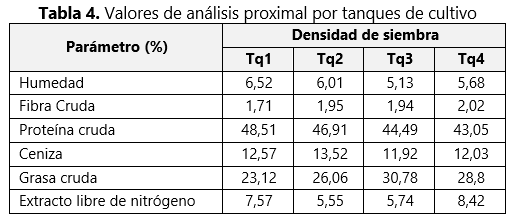Evaluation of culture densities of fingerlings of gamitana (Colossoma macropomum) under Ras system in the Peruvian Amazon
DOI:
https://doi.org/10.56926/repia.v1i1.8Keywords:
biometrics, crop, fish production, sowing, breeding systemsAbstract
The objective of the research was to determine the most optimal stocking density in the culture of fingerlings of gamitana (Colossoma macropomum) cultivated in a RAS system. Sowing was carried out in four geomembrane tanks (Tq) of 40 m3 capacity with densities Tq1 = 20, Tq2 = 40, Tq3 = 50 and Tq4 = 60 fingerlings/m3; Commercial food with 30% protein was supplied, which was reduced according to its nutritional requirement and biomass control for a period of 4 months, where biometrics (weight, height) were evaluated. The results of growth in average weight and length were Tq1 (115.24 and 7.5), Tq2 (100.82 and 7.14) and Tq3 (101.92 and 7.22) and Tq4 (79.62 and 6 .42) measured in centimeters and grams; the hematological profile shows a greater presence of glucose in Tq4; cholesterol and triglycerides in Tq2; and the proximal analysis indicates that crude protein and fat were (48.51 and 30.78) in Tq1 and Tq3 respectively. We conclude that Tq1 obtained better values in weight, length and the lowest seeding density, presenting a better percentage of protein and fat.
Downloads
References
Ahmed, N., & Turchini, G. M. (2021). Recirculating aquaculture systems (RAS): Environmental solution and climate change adaptation. Journal of Cleaner Production, 297, 126604. https://doi.org/10.1016/j.jclepro.2021.126604
Avirrama Perdomo, L. F., & Garcés López, N. Y. (2021). Determinación de parásitos en dos diferentes densidades de siembra de tilapia roja Oreochromis spp) en un sistema “RAS” en el municipio del Tambo (Cauca) [Universidad Antonio Nariño]. http://repositorio.uan.edu.co/handle/123456789/5882
Campos Baca, L. (2015). El cultivo de la gamitana en latinoamérica (G. Vargas Arana & M. Martín Brañas (eds.); 1st ed.).
Favero, G. C., Costa dos Santos, F. A., Soares da Costa Júlio, G., Cortezzi Pedras, P. P., Lima Ferreira, A., De Souza e Silva, W., Soares Ferreira, N., Do Carmo Neves, L., & Ronald Kennedy, L. (2021). Effects of short feed restriction cycles in Piaractus brachypomus juveniles. Aquaculture, 536, 736465. https://doi.org/10.1016/j.aquaculture.2021.736465
Galvez, J. I. (2019). Como eliminar insectos depredadores y peces silvestres de su estanque (p. 14). International Center for Aquaculture and Aquatic Environments. https://n9.cl/cvflt
Martins, A. P. L., Reissmann, C. B., Favaretto, N., Boeger, M. R. T., & De Oliveira, E. B. (2007). Capacidade da Typha dominguensis na fitorremediação de efluentes de tanques de piscicultura na Bacia do Iraí – Paraná. Revista Brasileira de Engenharia Agrícola e Ambiental, 11(3), 324–330. https://doi.org/10.1590/s1415-43662007000300013
Naspirán-Jojoa, D. C., Fajardo-Rosero, A. G., Ueno-Fukura, M., & Collazos-Lasso, L. F. (2022). Perspectivas de una producción sostenible en acuicultura multitrófica integrada (IMTA): una revisión. Revista de La Facultad de Medicina Veterinaria y de Zootecnia, 69(1), 75–97. https://doi.org/10.15446/RFMVZ.V69N1.101539
Nassiri, A., Thébaud, O., Holbrook, S. J., Lauer, M., Rassweiler, A., Schmitt, R. J., & Claudet, J. (2021). Hedonic evaluation of coral reef fish prices on a direct sale market. Marine Policy, 129, 104525. https://doi.org/10.1016/J.MARPOL.2021.104525
Natera, A., Hernandez, J., Telleria–Mata, N., & Henriquez, M. (2020). Technical aspects for cachama cultivation (Piaractus brachypomus & Colossoma macropomum). Ciencia En Revolución, 6(17). http://www.cienciaenrevolucion.com.ve/descarga/revista_edicion17.pdf#page=46
Ríos-Ramírez, O., & Bardales-del-Aguila, L. (2022). Efecto de los microorganismos eficaces (me), en la crianza de tilapia nilótica. Revista de Veterinaria y Zootecnia Amazónica, 2(1), e307. https://doi.org/10.51252/REVZA.V2I1.307
Soberón-Minchán, L. E., Chu-Koo, F. W., & Alcántara-Bocanegra, F. (2007). Parámetros hematológicos, crecimiento y composición corporal de juveniles de gamitana Colossoma macropomum (cuvier, 1818) cultivados en tres densidades. Folia Amazónica, 16(1–2), 35. https://doi.org/10.24841/fa.v16i1-2.286
Sousa, R. M., Rodrigues dos Santos Silva, R., Sousa dos Santos, A., Vieira da Silva, C., Avelar Magalhães, J., Helena dos Santos Fogaça, F., & Mello Lopes, J. (2020). Tambatinga juveniles performance in a recirculation aquaculture system with different stocking densities. Research, Society and Development, 9(5). https://doi.org/10.33448/rsd-v9i5.3317
Valenzuela Vargas, R., Martínez, P., & Arévalo, J. J. (2017). Evaluación preliminar de un sistema de recirculación de aguas para un prototipo implementado en la producción de tilapia roja (Oreochromis sp.). Ingeniería y Región, 18(2), 25–33. https://doi.org/10.25054/22161325.1737
Vásquez Gamboa, L. (2013). Sistemas de recirculación de agua (RAS) en Piscicultura. Revista Electrónica de Ingeniería En Producción Acuícola, 7(7), 1–7. https://revistas.udenar.edu.co/index.php/reipa/article/view/1483

Published
How to Cite
Issue
Section
License
Copyright (c) 2022 Magno Rosendo Reyes-Bedriñana, Marco Antonio Mathios-Flores, José Virgilio Aguilar-Vásquez, Oscar Alejandro Tuesta-Hidalgo, Juan Carlos Tuesta-Hidalgo, Juvenal Napuchi-Linares

This work is licensed under a Creative Commons Attribution 4.0 International License.
Authors retain their rights:
a. The authors retain the intellectual property rights (copyright) of the published works, assigning to the journal the right of first publication.
b. Authors retain their trademark and patent rights, and also on any process or procedure described in the article.
c. Authors retain the right to share, copy, distribute, perform and publicly communicate the article published in REPIA (e.g., place it in an institutional repository or publish it in a book), with an acknowledgement of its initial publication in REPIA.
d. Authors retain the right to make a subsequent publication of their work, to use the article or any part of it (e.g., a compilation of their work, notes for conferences, theses, or for a book), provided they indicate the source of publication (authors of the work, journal, volume, number, and date).







